|

 |
Green Cities Research Alliance
Urban Natural Resources Stewardship
|
Sustainable cities through science, policy, and action
RESEARCH PROJECTS
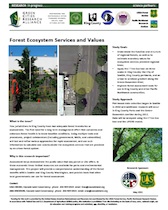
|
|
Forest Ecosystem Services and Values:
The first need for a long term management effort that conserves and enhances forest health is to know baseline conditions. Using multiple tools and procedures, project collaborators (including government, NGOs, and universities) will test and refine various approaches for rapid assessment, and use such information to calculate and communicate the ecosystem services that are provided by an urban forest system. pdf
Study Goals
![[Bullet]: arrow](USFS_files/main-body-1.gif) Understand the function and structure of regional forests, as well as to estimate monetary values for ecosystem services provided by regional trees, Understand the function and structure of regional forests, as well as to estimate monetary values for ecosystem services provided by regional trees,
![[Bullet]: arrow](USFS_files/main-body-1.gif) Apply the i-Tree Eco tool on three scales in King County: the City of Seattle, King County parklands, and an urban to wildland gradient along the Green-Duwamish River, Apply the i-Tree Eco tool on three scales in King County: the City of Seattle, King County parklands, and an urban to wildland gradient along the Green-Duwamish River,
![[Bullet]: arrow](USFS_files/main-body-1.gif) Improve forest assessment tools for use in King County and other Pacific Northwest communities. Improve forest assessment tools for use in King County and other Pacific Northwest communities.
|
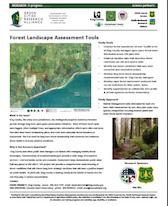
|
|
Forest Landscape Assessment Tools:
Many local jurisdictions have strategically acquired numerous forested parcels through long term open space conservation initiatives. Few sites have forest stewardship plans, and most need adequate forest inventory or assessment. Forested areas of urbanized landscapes provide a wide range of ecosystem services – environmental, social, and economic. Assessment helps demonstrate public value that any parcel or site offers. pdf
Study Goals
![[Bullet]: arrow](USFS_files/main-body-1.gif) Develop rapid forest assessment protocols that can be used to establish baseline conditions and health, and that can be replicated on other public lands, Develop rapid forest assessment protocols that can be used to establish baseline conditions and health, and that can be replicated on other public lands,
![[Bullet]: arrow](USFS_files/main-body-1.gif) Conduct forest assessment on over 23,000 acres of King County managed open space forest lands distributed across 150 park sites, Conduct forest assessment on over 23,000 acres of King County managed open space forest lands distributed across 150 park sites,
![[Bullet]: arrow](USFS_files/main-body-1.gif) Develop long term forest stewardship recommendations, and identify opportunities to collaborate with public & private agencies on forest stewardship. Develop long term forest stewardship recommendations, and identify opportunities to collaborate with public & private agencies on forest stewardship.
|
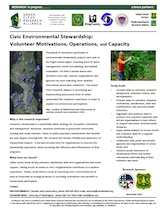
|
|
Civic Environmental Stewardship Motivations:
More and more citizens and organizations are working on behalf of the environment. Volunteers at stewardship events throughout the metro Seattle area are being surveyed to learn more about stewardship motivations, satisfactions, and project contributions. Results will help us to understand how to better recruit, retain, and support the 1,000s of people who contribute their time and effort. pdf
Study Goals
 Work with stewardship project sponsors and organizations to better understand their program needs, Work with stewardship project sponsors and organizations to better understand their program needs,
 Interact with project participants (volunteer and paid) to better understand why and how they choose to be involved, Interact with project participants (volunteer and paid) to better understand why and how they choose to be involved,
 Assess and implement effective ways to recruit and retain program participants, and Assess and implement effective ways to recruit and retain program participants, and
 Create guidelines for program managers and leaders so that project learnings are shared across programs. Create guidelines for program managers and leaders so that project learnings are shared across programs.
|
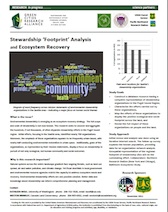
|
|
Stewardship 'Footprint' Analysis and Ecosystem Recovery:
Environmental stewardship is emerging as an ecosystem recovery strategy. There are hundreds of organizations that do resource stewardship projects across most metro areas. What are the effects of such work? Comprehensive mapping will reveal the “footprint” of ecological benefit, and show where citizen action is most effective. Other data will reveal additional social and economic benefits. pdf
Study Goals
 Complete an inventory, assessment, and database of environmental stewardship organizations in the metro Seattle area, Complete an inventory, assessment, and database of environmental stewardship organizations in the metro Seattle area,
 Map projects and activity sites using GIS so that the full scope and scale of stewardship becomes visible, as well as the positive social and ecological footprints of stewardship programs Map projects and activity sites using GIS so that the full scope and scale of stewardship becomes visible, as well as the positive social and ecological footprints of stewardship programs
 Characterize the stewardship programs supported by organizations, including their alignment with environmental policy and restoration initiatives. Characterize the stewardship programs supported by organizations, including their alignment with environmental policy and restoration initiatives.
|
| |
|
placeholder: Stewardship Organization Network Analysis:
|
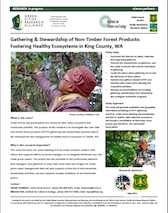
|
|
Urban Foraging: Gathering and Stewardship of Non-Timber Forest Products:
Urban forests and greenspaces are valued for their many ecosystem and community benefits. The purpose of this research is to investigate the roles that non-timber forest products (NTFPs) gathering and stewardship practices play in the development and management of healthy forest ecosystems in Seattle, WA.pdf
Study Goals
 Document the diversity of plants, materials, and fungi being gathered, and better understand the places where gathering occurs, Document the diversity of plants, materials, and fungi being gathered, and better understand the places where gathering occurs,
 Describe the characteristics of gatherers, and the social, economic, and cultural importance of gathering, Describe the characteristics of gatherers, and the social, economic, and cultural importance of gathering,
 Examine how gatherers steward NTFPs and interface with urban forest planning and restoration activities, and Examine how gatherers steward NTFPs and interface with urban forest planning and restoration activities, and
 Develop recommendations for including gathering considerations into stewardship and ecological restoration programs. Develop recommendations for including gathering considerations into stewardship and ecological restoration programs.
|
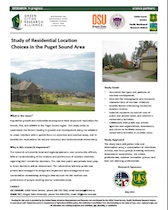
|
|
Residential Location Choices and Natural Resources:
To understand the factors leading to growth and development along the wildland to urban interface (with focus on suburban and exurban areas). pdf
Study Goals
 Document the types and patterns of exurban development, Document the types and patterns of exurban development,
 Describe demographic and economic characteristics of exurban residents, Describe demographic and economic characteristics of exurban residents,
 Identify factors influencing residential location choices, Identify factors influencing residential location choices,
 Examine residents’ recreation uses of public and private lands, and interest in stewardship activities, and Examine residents’ recreation uses of public and private lands, and interest in stewardship activities, and
 Collaborate with public & private agencies and organizations, landowners, and others to facilitate resource stewardship activities in exurban areas. Collaborate with public & private agencies and organizations, landowners, and others to facilitate resource stewardship activities in exurban areas.
|
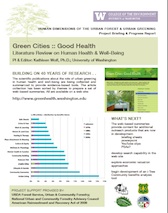
|
|
Green Cities for Good Health:
In recent decades new knowledge about the environmental benefits of urban trees and green spaces (such as air and water quality improvements) has been widely communicated. Nearly 40 years of research also provides evidence about how urban greening aids human health and well-being and makes cities more livable. A research review, prepared as a collection of science summaries, is now available on the web and provides evidence for why nearby nature is essential for all who live, work, and learn in urban environments. pdf
Project Goals
 Share social science and human dimensions research with urban natural resources decision-makers and managers, Share social science and human dimensions research with urban natural resources decision-makers and managers,
 Provided an expanded framework for how urban nature helps build social capital in communities, Provided an expanded framework for how urban nature helps build social capital in communities,
 Translate science findings that are distributed across many disciplines (such as psychology, sociology, urban planning, public health, geography and others) into focused science delivery products, and Translate science findings that are distributed across many disciplines (such as psychology, sociology, urban planning, public health, geography and others) into focused science delivery products, and
 Assemble the data and findings that can be used for additional economic valuation studies, and development of an i-Tree Community module. Assemble the data and findings that can be used for additional economic valuation studies, and development of an i-Tree Community module.
|
revised November 2011 |
|
|